My Apple 'Book Journey: The Road Best Traveled
by Charles W. Moore
Greetings. This is my first The Logical Mac column for PowerBook Central. Stephen Hildreth of has invited me to share news, perspectives, reviews, and how tos here every week, and I'm delighted to be aboard one of the most venerable and respected Apple portable sites on the Mac Web.
I expect that many readers will be acquainted with my scribbling about Apple 'Books and other matters on MacOpinion, Applelinks, and Low End Mac, which will continue as before, so this column is an addition and not a shift.
For those who may be reading me for the first time, I thought a bit of introduction would be appropriate. I've been a working journalist full time for the past eighteen years, and a dabbler for a lot longer. Besides my Mac Web gigs, I appear in a variety of print media, mostly Canadian newspapers and magazines, covering beats that usually have little or nothing to do with computers.
My affinity for the Mac developed out of my switch from a typewriter to digital word processing in the early '90s. My first computer wasn't a Mac, but rather a big old Wangwriter II dedicated word processor that a cousin of mine obtained surplus from the telco he worked for which was switching to 386 PCs in its office operation. The Wang was actually a very decent tool, with the most user-friendly command line/menu-driven interface I've ever used. I still have it and it still works, running off 5 1/4 inch floppy system disks.
However, in 1992 I got a magazine writing and editing gig with a publisher that had an all-Mac shop, so a reasonable requirement was for me to get a Mac in order to be able to file stories on 3 1/2 inch floppies and also handle graphics, which the Wang couldn't do. As it happened, a university professor friend had a Mac Plus rig for sale, including a whopping 20 MB external hard drive and an ImageWriter II dot-matrix printer, which I agreed to buy for a bit less than the price of a new iBook today.
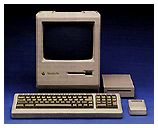
The old Mac Plus had a whole megabyte of RAM, and an 8 MHz 68000 Motorola processor, and Mac system 6.0.1, which I soon upgraded to System 6.0.3 in order to support Microsoft Word 5.1. I also had the RAM upgraded to a luxurious 2.5 MB, which allowed me to keep my two main production applications, Word and HyperCard opened simultaneously using the System 6's "Multifinder" feature.
With its little nine-inch 8-bit, monochrome screen, you had to scroll to read a single page of text, but the display was satisfyingly sharp, and using the software of the day, performance was pretty decent.
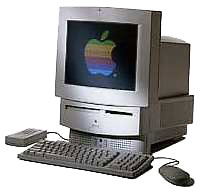
However, I soon had a hankering for a color screen, more desktop real estate, and more power, so at the turn of 1994, I purchased my second Mac, a 25 MHz, 68030, all-in-one LC 520, which had a built-in CD-ROM drive and a wonderfully clear and sharp 640 x 480 Sony Trinitron monitor. The LC 520 served me well, and even ushered me into the Internet age. It still works fine (as does the old Mac Plus).
But those desktop Macs were just the overture to the real story here: my journey down the PowerBook (and iBook) road.
The first 100 series PowerBook I ever got my hands on was a 165c belonging to a friend. The 165c was Apple's first stab at making a color PowerBook. It wasn't an unqualified success. The truncated resolution 640 x 400 passive matrix display was, to put it charitably, a tad murky, and battery life was little more than an hour on a fully charged new battery.
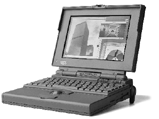
And yet.... The PowerBook grabbed me like no other computer had. I already liked Macs a lot, but I instantly fell in love with the PowerBook. I was enchanted by the clever miniaturization of the features of my desktop Macs into such a fetchingly compact unit. This, it seemed to me, was the quintessentially logical computer -- the logical Mac. The original conception of the Macintosh was as a compact, somewhat portable system, and the PowerBook enhanced both qualities. I had to have one.
However, I'm not an impulsive buyer. I considered the PowerBook 150, which was selling deeply discounted at the time, but ruled it out as a bit too close to my LC 520 performance-wise. I wanted my PowerBook to be a system upgrade as well.
I was quite smitten with the mighty PowerBook 500 series, but they were sooooo expensive, and Power PC was coming. Cutting to the chase, I finally took the plunge in the fall of 1996, buying an end-of-line PowerBook 5300, with a 9.5-inch grayscale passive matrix display and a 100 MHz Power PC 603e processor.
I loved the 5300 from the moment I lifted it from its box. The clean, squared-off styling and small footprint (very close to that of the 12-inch iBook today) appealed to me aesthetically. On the downside, while the 5300 represented a significant, albeit not spectacular performance upgrade from the LC 520, it was not nearly as fast as I had hoped, and the operating system that shipped with it, version 7.2, was a dog. Boosting the RAM to 24 MB and upgrading to System 7.5.5 improved performance and stability a lot, and I found that running from a RAM disk also speeded things up significantly, as well as facilitating blissfully quiet computing with the hard drive spun down. Shades of the old Mac Plus running from a floppy system disk.
The 5300 served as my main workhorse for three years, and I was as fond of it at the end as I was at the beginning, but as the Internet became a more central focus of my work, the cramped 640 x 480 grayscale display and the lazy performance online proved seriously inadequate.
In late 1998, I was moonlighting has a sales agent for an Apple reseller, and had one of the early 233 MHz WallStreet power books -- the "MainStreet" model with no L2 cache and a 12.1-inch passive matrix screen -- as a demo, so I decided to experiment with pressing it into service as a production machine. There was no going back. Even without an L2 cache, the G3 WallStreet was a quantum performance leap from the old 5300. I even found that I liked the much -maligned dual scan display, and the scissors-action keyboard was sublime. After a couple of weeks on the G3, I placed an order for a 233 MHz WallStreet of my own, but the one with a 12.1-inch TFT active matrix display and 512K of L2 cash.
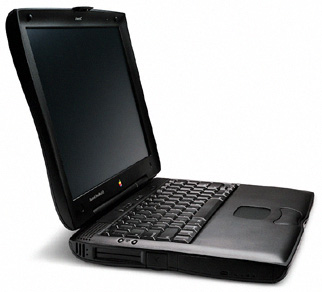
I'm still using that computer daily as my knockabout "laptop" laptop, but it was my number one computer for more than three years. It's still a great old machine, although it is the only Mac I've ever owned that suffered a major hardware failure.
On August 1st, 2002, with no warning, the WallStreet's processor died. The PowerBook ended up sitting around for fourteen months until the problem was diagnosed and I scrounged up a replacement processor daughtercard. That cured it, and it's not missed a beat in the past 13 months. Now six years old, the original battery still gives me at least an hour of running time.
The WallStreet has been hotrodded a bit over the years. It has 192 MB of RAM, the original 2 GB IBM hard disk has been upgraded to a 10 GB Toshiba unit with a megabyte of buffer cache, and it has FireWire and USB adapter PC Cards - - both by MacAlly. With these upgrades and its built-in array of legacy PowerBook I/0 ports, the WallStreet is a connectivity ace.
I am running OS 9.2.2 on the WallStreet, which gives it lively performance, and is stable as a rock. In the past I've had both SuSE and Yellow Dog Linux installed on this machine, but have had poor luck getting OS X to install. I don't consider that a major hardship with a 233 MHz G3 processor; X would be sluggish.
In the fall of 2001, I became a PowerBook 200o Pismo owner, trading a five month old G4 Cube that I thought was neat but never really warmed to, for a year-old Pismo in immaculate condition. It is a top-of-the-line late production model, with a 500 MHz G3 processor and a 20 GB hard drive. It also had 256 megabytes of RAM and both the Zip and SuperDisk/floppy the expansion nay modules.
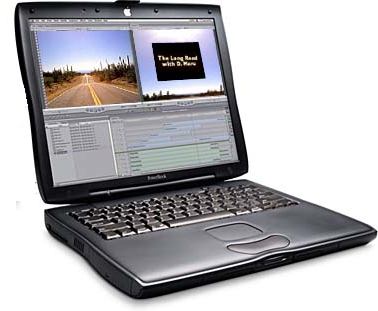
The Pismo was pressed into service as my OS X learning platform, a role it inherited from the Cube. I bumped up the RAM to 640 MB, and installed OS 10.1, while the WallStreet remained my front-line production machine. When the WallStreet broke nine months later, I switched smoothly to the Pismo, first in OS 9, but soon to OS X 10.2 Jaguar.
However, I prefer to have two computers capable of full tilt production duty with no compromises on hand, so at New Year 2003 I bought a 700 MHz G3 iBook -- the entry-level model with a 20 gigabyte hard drive and a plain-vanilla CD-ROM drive. I maxed out the RAM at 640 MB, but otherwise the iBook remains stock to this day. It's been completely reliable for nearly two years and I have no complaints or regrets about purchasing it.
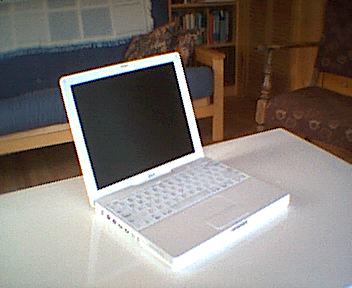
Despite only a 200 MHz advantage in clock speed, the iBook proved significantly faster the Pismo in OS X (its 16 megabytes of video RAM and RADEON 7500 video card supporting Quartz Extreme in Jaguar and Panther helped), and it became top dog in the pack for a while.
I also had "inherited" and old 117 MHz PowerBook 1400 from my daughter, who had come into a faster, 133 MHz, 1400, and I began using the old 'Book for drafting and the editing.
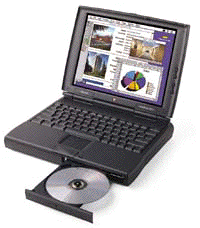
In the fall of 2003, OS X 10.3 Panther was released, and I found that it gave the 500 MHz Pismo a bit of a new lease on life, proving roughly 20 percent faster for many things than Jaguar had been.
That encouraged me to embark on a major hotrodding project for the old PowerBook. First up was a 550 MHz G4 processor transplant from Daystar/XLR8. I've been entirely pleased with the upgrade, which has leapfrogged the Pismo past the iBook as the performance leader in my fleet of 'Books.
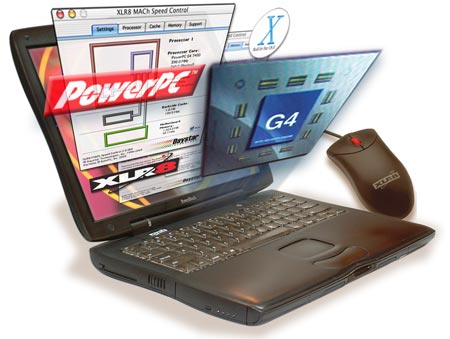
Other hotrodding tweaks included doubling the capacity of the hard drive to a 40 gigabyte Toshiba 5400 RPM unit with 16 megabytes of buffer cache, a FireWire 800 PC card adapter from Miglia, and a Superdrive 4x DVD-burning optical drive module from FastMac.
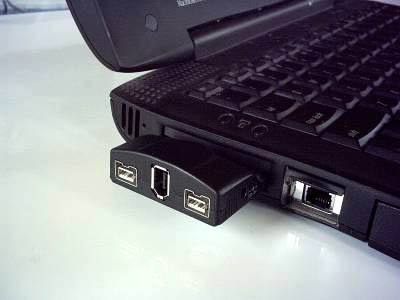
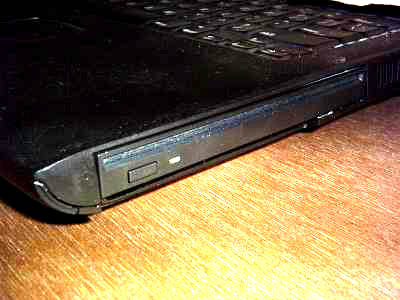
The Pismo, with just 550 MHz and its non-upgradable 8MB of video RAM on a mediocre RAGE 128 video card is not in the same league with even the lowest-end current G4 iBooks and PowerBooks, but it's still a nice piece, and a reliable, very attractive, and pleasant-to-use computer. It has the best keyboard of any of my 'Books, save perhaps for the ancient 1400.
Speaking of which, it was passed onto my wife (who had been using the LC 520) when I resuscitated the WallStreet last fall.
As for the others, my daughter took over the 5300 when I first bought the WallStreet. It still works, but hasn't really been in regular use now for a couple of the years. The 133 MHz 1400 has also just been retired, and replaced with a new, 1.2 GHz iBook.
What's next? I'm currently happy with the service on getting from the iBook, Pismo, and WallStreet, but were right in the market for a new system today, my short list would include another 12 inch iBook and the 12-inch PowerBook. In most respects, I would be completely satisfied with the iBook, which is a spectacular deal at $999, but I don't really like the iBook keyboard, and the 12-inch little Al has a dandy one.
In the meantime, like most other Apple portable aficionados, I'm intrigued as to what Apple is going to do regarding the much-anticipated G5 PowerBook. Personally, I'm inclined to think that there will be G4 iBooks and PowerBooks for a long time yet, perhaps with some of the new G4 chips by being rolled out by Freescale. However, I expect that some sort of G5 PowerBook will eventually merge. I'm guessing late 2005.
I'm sure we'll be revisiting that topic in future columns. Hope you'll be tuning in to The Logical Mac as the journey continues.